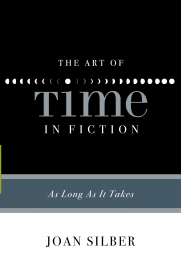Silber, Joan (2009). The Art of Time in Fiction: As Long as it Takes. Minneapolis, MN: Greywolf Press, 114pp.
I bought this book on the recommendation of a writing instructor when I was having trouble presenting backstory. The book was not very helpful. It is not a “how-to” book. Like the others in this series (The Art of X in Writing), it’s a short (114 small-sized pages) essay, strictly an overview. The success of the format depends on the writing skill of the author and his or her degree of insight into the topic. Baxter’s The Art of Subtext was revelatory, proving that the formula can work. This one however, is only mildly interesting.
Silber spends most of her essay on “Classic Time,” where the story is told from beginning to end in a straightforward manner. This is the least interesting, most obvious, and least problematic time structure for writers, although I did appreciate the insight, taken from Virginia Woolf’s “To the Lighthouse,” that one nifty technique is to contrast the inexorable and mindless time of nature (tides, seasons, decay and rebirth, etc.) with the sharp intentionality of human time, which is outside of nature.
There is insight to be had from this book, but Silber spends most of her word count reviewing plot and characters of various example stories, usually not drawing out a clear lesson of fictional time. From a long consideration of Proust’s “Recherche,” we learn that “Time, in fiction, is infinitely flexible.” You would have to be an extremely naïve writer to not know that fiction can compress and elongate time. In other examples (e.g., Maupassant and Flaubert), we learn that it is possible to show characters aging over a whole lifetime. How this is best done is only hinted at.
The other “kinds” of fictional time covered are even less useful. My particular concern, how best to represent backstory, is covered in a short section called “Switchback Time.” There I discover that flashbacks and other time cuts are possible in fiction, something I was quite aware of. Examples don’t make any particular point. Alice Munro’s stories are recommended, but without much discussion of why, beyond the conclusion that “Different characters can tell a tale in different ways.” Hemingway eschewed the past, preferring to stay in the present, “without dawdling in the lyrical.” Lots of examples are cited for each of these points, but the points themselves are superficial.
Fabulous, or non-realistic time, is not even defined. The main example is Marquez’s famous opening line from 100 years: “Many years later, facing a firing squad, A. would remember X from childhood.” (A crude paraphrase, I apologize). What is so fabulous, or magical or nonrealistic about that? It’s a remarkable sentence, and a remarkable phenomenology, but what I want to know is how to tell a story in forward gear while providing context from the past. As I recall 100 years, that book simply jumps from the firing squad into the deep past.
In the final section, “Time as Subject,” we learn that all stories (logically) end in death, that everyone is surprised to get old, and that death ends subjective time. Examples from The Death of Ivan Illyich are apposite, but offer no help for a writer. This topic, which amounts to little more than the assertion that time exists, seems out of place in a book about managing time in fiction.
Overall, I extracted a half-dozen crumbs of insight, and I’ll probably read more Alice Munro now, but overall, I didn’t see much in this book that isn’t covered in any generic how-to-write book. I had high expectations because of Baxter’s book on subtext, learned a few tricks, but was generally disappointed here.

